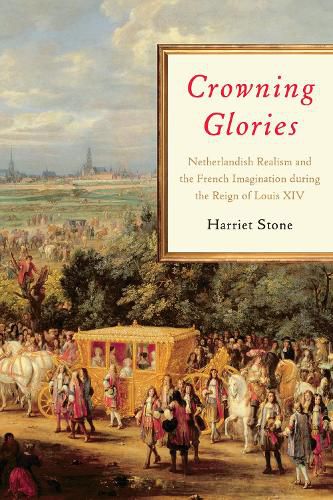Readings Newsletter
Become a Readings Member to make your shopping experience even easier.
Sign in or sign up for free!
You’re not far away from qualifying for FREE standard shipping within Australia
You’ve qualified for FREE standard shipping within Australia
The cart is loading…






Crowning Glories integrates Louis XIV’s propaganda campaigns, the transmission of Northern art into France, and the rise of empiricism in the eighteenth century - three historical touchstones - to examine what it would have meant for France’s elite to experience the arts in France simultaneously with Netherlandish realist painting. In an expansive study of cultural life under the Sun King, Harriet Stone considers the monarchy’s elaborate palace decors, the court’s official records, and the classical theatre alongside Northern images of daily life in private homes, urban markets, and country fields.
Stone argues that Netherlandish art assumes an unobtrusive yet, for the history of ideas, surprisingly dramatic role within the flourishing of the arts, both visual and textual, in France during Louis XIV’s reign. Netherlandish realist art represented thinking about knowledge that challenged the monarchy’s hold on the French imagination, and its efforts to impose the king’s portrait as an ideal and proof of his authority. As objects appreciated for their aesthetic and market value, Northern realist paintings assumed an uncontroversial place in French royal and elite collections. Flemish and Dutch still lifes, genre paintings, and cityscapes, however, were not merely accoutrements of power, acquisitions made by those with influence and money. Crowning Glories reveals how the empirical orientation of Netherlandish realism exposed French court society to a radically different mode of thought, one that would gain full expression in the Encyclopedie of Diderot and d'Alembert.
$9.00 standard shipping within Australia
FREE standard shipping within Australia for orders over $100.00
Express & International shipping calculated at checkout
Crowning Glories integrates Louis XIV’s propaganda campaigns, the transmission of Northern art into France, and the rise of empiricism in the eighteenth century - three historical touchstones - to examine what it would have meant for France’s elite to experience the arts in France simultaneously with Netherlandish realist painting. In an expansive study of cultural life under the Sun King, Harriet Stone considers the monarchy’s elaborate palace decors, the court’s official records, and the classical theatre alongside Northern images of daily life in private homes, urban markets, and country fields.
Stone argues that Netherlandish art assumes an unobtrusive yet, for the history of ideas, surprisingly dramatic role within the flourishing of the arts, both visual and textual, in France during Louis XIV’s reign. Netherlandish realist art represented thinking about knowledge that challenged the monarchy’s hold on the French imagination, and its efforts to impose the king’s portrait as an ideal and proof of his authority. As objects appreciated for their aesthetic and market value, Northern realist paintings assumed an uncontroversial place in French royal and elite collections. Flemish and Dutch still lifes, genre paintings, and cityscapes, however, were not merely accoutrements of power, acquisitions made by those with influence and money. Crowning Glories reveals how the empirical orientation of Netherlandish realism exposed French court society to a radically different mode of thought, one that would gain full expression in the Encyclopedie of Diderot and d'Alembert.